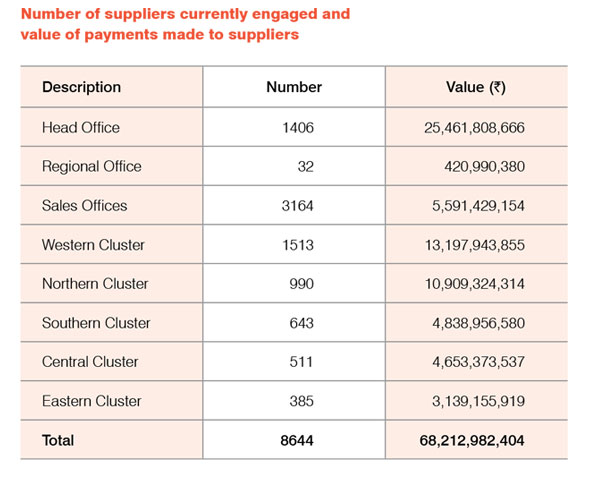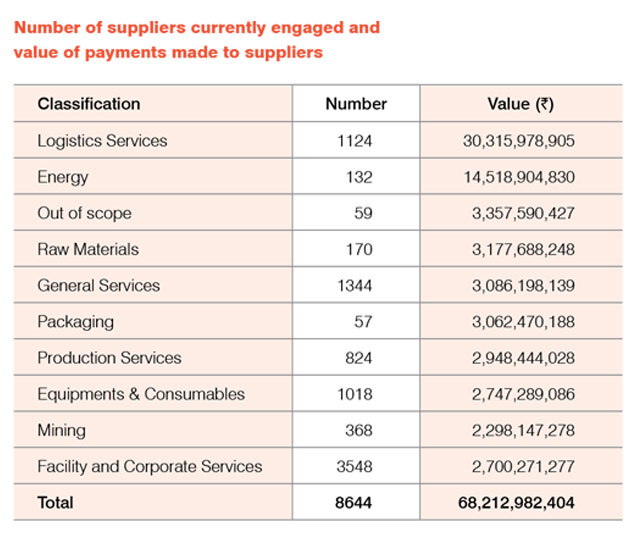Business. Moving past the blocks.
Sustainable Supply Chain GRI 204, 409, 414.
Our procurement operations are well connected with our manufacturing as well as sales units spread across the country. Local procurement teams take care of dayto-day purchase requirements, while India Procurement Organisation (IPO) at our head office manages high value purchase of commodities. Individual units communicate their requirements to IPO and purchases are made centrally. Preferred vendors are those who demonstrate good corporate citizenship and promote sustainable development. They meet our quality and delivery specifications. They are spread across the country and include reputed manufacturers and trusted brand names; usually they are the leading 3-4 vendors of their particular industry segment.
All suppliers operating within Indian Territory are termed as local or national suppliers. Our management approach towards the supply chain has been to identify various risks involved and convert them into opportunities to ensure the sustainability of our supply chain. As part of our Sustainable Procurement Initiative (SPI) we assess our suppliers who are allocated with a sustainability risk rating based on the methodology defined in our SPI manual. Through this process we have mapped our suppliers as having a high, medium or low risk. Our ‘2030 PLAN’ aims to have 100% of high-risk active suppliers assessed and consequence managed by 2030. In order to strengthen our supply chain assessment and monitoring, we have engaged a third party, global consultant Avetta (PICS) to help us manage and take corrective action on identified risks through an assessment tool. Avetta helps to qualify existing and new vendors on the basis of their performance in health and safety, human rights, legal, environmental and ethical issues as defined in the Supplier Code of Conduct (SSC). The exercise in 2016 covered 4% of existing high-risk-high-spend suppliers/ vendors who accounted for about 40% of procurement value excluding Government spends. High-risk-highspend suppliers at the regional level, across all areas of operation, are trained on aspects of ethics, anticorruption and anti-bribery. In 2016 we engaged with 8,644 tier 1 suppliers of which 715 were identified as critical to our operations. The payments made to suppliers in 2016 amounted to about ` 6,821 crore.

Our procurement policy includes a code of practice that encourages fair, open and transparent competition.
Contractual Agreement of Compliance GRI 308-2, 414-1, 414-2
All our purchase orders and agreements incorporate clauses related to occupational health and safety (OH&S), environment management, labour standards and social responsibility. New suppliers are informed of our expectations, provided with a copy of the Supplier Code of Conduct (SSC), and their consent to follow the SSC obtained. The SSC provides a summary of the Company’s expectation from its suppliers/contractors in all procurement dealings. It lists out nine standards that suppliers must adhere to, besides complying with local and national statutes: OH&S; Working Conditions; Freedom of Association and Non-retaliation; Forced Labour; Child Labour; Non-discrimination; Environmental Regulatory Compliance; Management of Environmental Impact; and Bribery and Corruption. The SSC covers the standards specified in SA 8000 and ISO 14000. It is the Company’s practice to only employ staff having a minimum age of 18 years. Those below 18 years of age are not allowed to enter into the plants. ACL also ensures that its contractors strictly comply with these guidelines.

We have a system of self-declaration in which vendors answer basic questions about their compliance with these aspects and standards. All suppliers must complete the Supplier CSR and OH&S management system questionnaire as a condition for eligibility.
Environmental Principles in Procurement GRI 308
All agreements with suppliers have the suppliers’ signed consent to comply with SA8000, environmental management and legal requirements. About 5% of our new suppliers have been screened using environmental criteria.